This article will examine the effectiveness of Bollinger bands on one of the world’s most popular cryptocurrencies, ETH, the native token of the Ethereum platform.
Bollinger bands are one of the most widely used analytical tools in trading. They were first proposed by John Bollinger in the 1980s and are based on the idea that prices tend to stay within certain ranges.
What are Bollinger Bands
Bollinger bands consist of three lines: the upper band, the lower band, and the average price. The upper band is calculated by adding twice the standard deviation of price to its moving average. The lower band is calculated by subtracting twice the standard deviation from its moving average. Usually the use of the indicator is proposed on the last 20 periods, that is, the last 20 bars, and the moving average will be calculated on these.
There are multiple ways of using this indicator in trading, but it is usually used in mean reverting or trend following strategies.
Given the marked tendency of Ethereum (ETH), and cryptos in general, to follow trends, we will lean toward the trend following type, which allows us to start with the development from an engine that tends to be more inclined to follow the characteristics of the underlying asset we are going to look at.
A strategy based on Bollinger bands applied to Ethereum (ETH)
The strategy, which will be built only on the long side, in fact assumes entering on extended market movements, with the idea that the initial movement may continue in the direction taken. To give an example: upon the occurrence of a 30-minute bar close above the upper band, the strategy will enter a long position. Trade closure, on the other hand, will occur on the occurrence of a bar close below the lower band, or at the end of the session. Session that is calculated in exchange time (normally Greenwich GMT is used) from midnight to midnight the following day.
Applying this strategy on the Ethereum (ETH) market from September 2016 to September 2023 yields positive results right away, with an increasing equity line. In the following figures we see how, using a fixed size of $10,000 per trade, the total profit of the system exceeds $60,000 in 1850 trades, with an average trade of $33. These results still denote a crude strategy, with lots of trades and a less than exciting average trade when compared to the size used (33/10,000=0.33%).
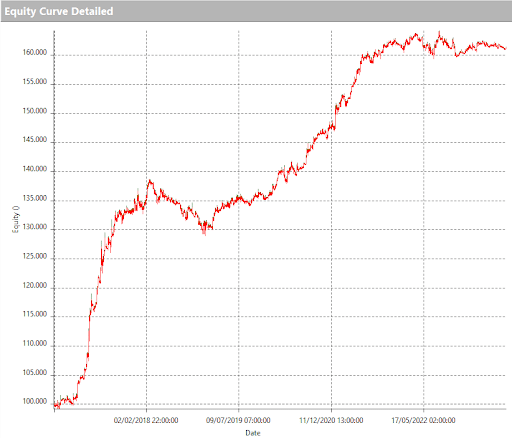
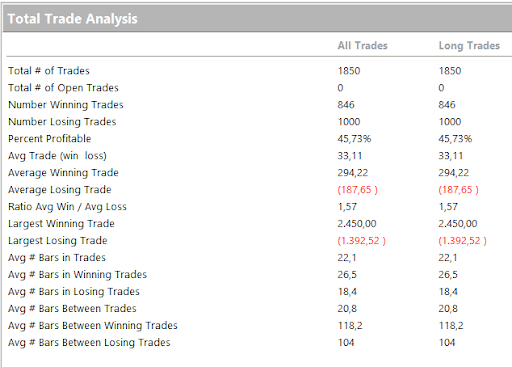
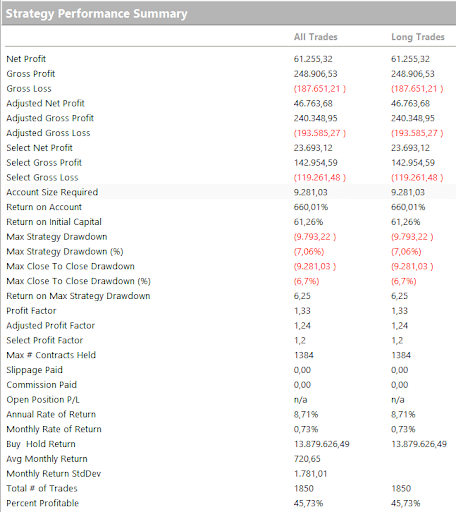
Optimization of Bollinger bands based strategy applied on Ethereum (ETH)
The strategy does not currently include the use of a stop loss, but this could help improve the drawdown figure, as well as could shelter against any losses that are too large. Figure 4 shows how by varying different stop losses from 1 percent to 15 percent (last column on the right) of the position value, there are interesting results, especially in terms of drawdown.

With a stop loss at $300 (3% of $10,000), the system improves the drawdown figure. It goes from the previous -$9,793 to almost half, -$5,833. The net profit remains almost unchanged, the delta from the previous reading is only $301.53, and the average trade remains almost unchanged.
However, it is precisely the average trade that is the Achilles’ heel of the system. $32.4 is low for the strategy to be considered ready for live trading.
Therefore, to try to improve the metrics, we proceed with optimizing the periods of the bands to see if they can in fact improve the performance of the system.

In Figure 5, optimizing the periods of the Bollinger Bands does not show significant improvement. True, with 40 periods the average trade increases, keeping the net profit constant and slightly lowering the drawdown. However, it is enough to move to the 30-period level to see the average trade again in line with previous readings. Perhaps optimizing the indicator periods was not a great idea, as improvements are only seen around the 40-period level, while all the others around it do not seem to maintain the same numbers.
It therefore comes to mind that it is not the Bollinger bands that are malfunctioning, not least because in fact it was seen early on that the indicator provides good results. Perhaps it should be used in conjunction with other conditions that can identify the best days on which to execute buy trades.
Adding a pattern to the strategy with Bollinger bands applied on Ethereum (ETH)
For this purpose, we will use a proprietary list that brings together within it many different price combinations that will be used to understand in which situations Ethereum (ETH) seems to work best with Bollinger bands.

The “MyPtn=0” case (Figure 6) identifies the situation seen until recently. And it can be seen that in fact MyPtn number 7 manages to increase the average trade ($40) and net profit ($66,498.63). The drawdown also decreases slightly and stands at -$4,304.86. This is a good improvement, which is also visible in the shape of the equity, which takes a smoother shape (Figure 7).
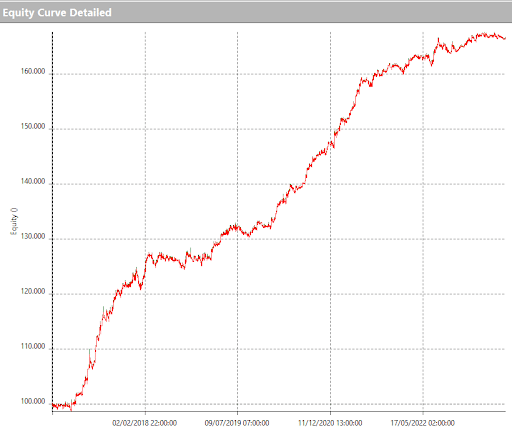
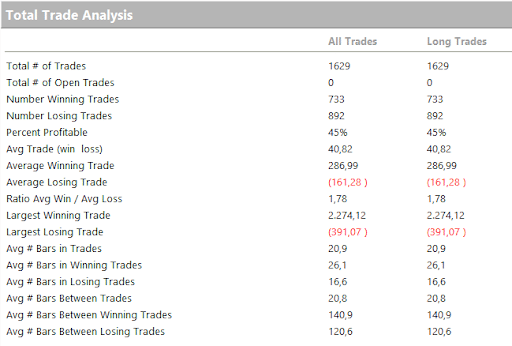
The newly added condition actually filters out those days that are following a session with low conviction, a day when the “body” of the daily candle (open-close) was not more than 75 percent of the total range of the daily candle (high-low). Figure 9 shows an example of the pattern in question. Therefore, we would like to avoid those situations where the “body” is greater than 75% of the total range of the session.

With the addition of the pattern, good results were seen, certainly still far from what would have been achieved with the simple “buy & hold” of Ethereum (ETH) from 2016 to the present (visible in Figure 10). Through the “buy & hold” the net profit would have been $1,378,254, compared to a drawdown of -$3,358,419. To be fair, the fluctuations of the “buy & hold” are not comparable to those experienced by the trading system. On the one hand the coronaries would have been put to the test, on the other hand the trend would certainly have been smoother. In addition to this, it should be considered that the trading system uses a fixed size, whereas in the “buy & hold” it is as if one were reinvesting the profits obtained.
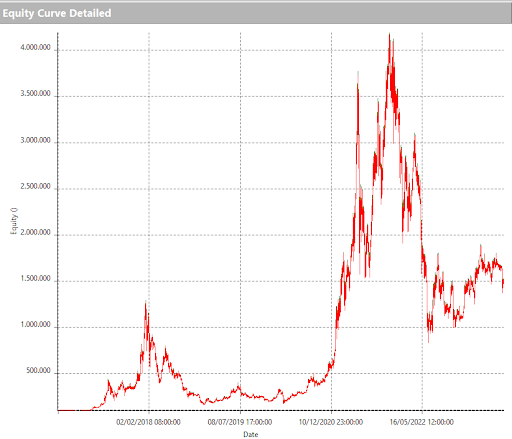

Conclusions on Bollinger bands strategy applied to Ethereum (ETH)
The Bollinger bands strategy has certainly proven to be interesting on Ethereum (ETH). However, the addition of the pattern was the move that resulted in the most significant improvement, especially in the shape of the final equity line and the total profit achieved.
Bollinger bands can thus be a usable indicator for live trading and across multiple different markets. Ethereum (ETH) responded well to this indicator, despite being a rather young market, demonstrating once again the effectiveness of Bollinger bands for building trading systems.
Until next time and happy trading!
Andrea Unger
 en.cryptonomist.ch
en.cryptonomist.ch
